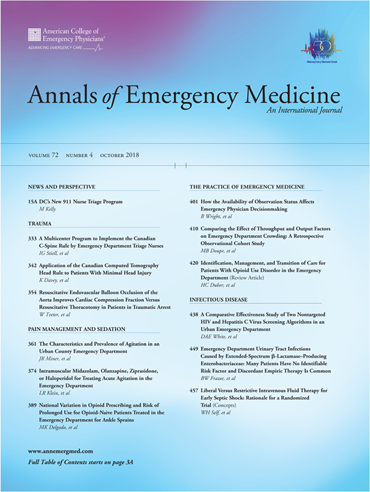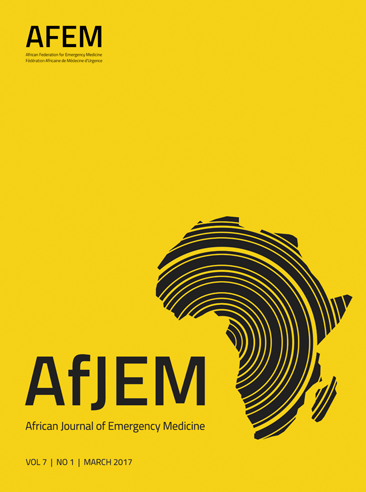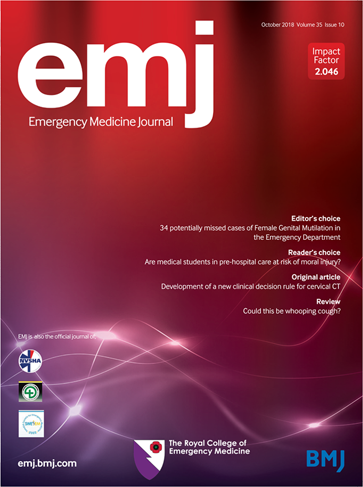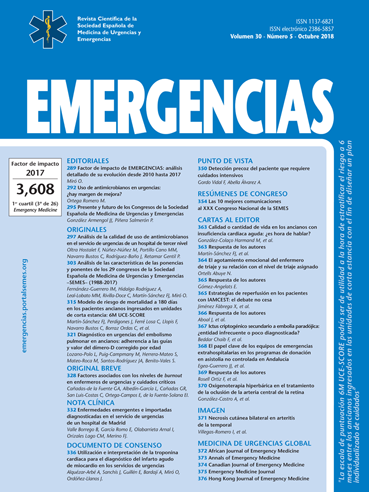Annals of Emergency Medicine

Official journal of the American College of Emergency Physicians
(The print version of this article has been scheduled for Septmeber 2020)
Predicting Hospital Admission and Prolonged Length of Stay in Older Adults in the Emergency Department: The PRO-AGE Scoring System
Pedro K. Curiati, Luiz A. Gil-Junior, Christian V. Morinaga, Fernando Ganem, Jose A.E. Curiati, Thiago J. Avelino-Silva
https://doi.org/10.1016/j.annemergmed.2020.01.010
Objective We developed prediction models for hospital admission and prolonged length of stay in older adults admitted from the emergency department (ED).
Methods This was a retrospective cohort study of patients aged 70 years or older who visited a geriatric ED in Brazil (N=5,025 visits). We randomly allocated participants to derivation and validation samples in a 2:1 ratio. We then selected 21 variables based on their clinical relevance and generated models to predict the following outcomes: hospital admission and prolonged length of stay, defined as the upper tertile of hospital stay. We used backward stepwise logistic regressions to select our final predictors and developed risk scoring systems based on the relative values of their β coefficients.
Results Overall, 57% of the participants were women, 31% were hospitalized, and 1% died in the hospital. The upper tertile of hospital stay was greater than 7 days. Hospital admission was best predicted by a model including male sex, aged 90 years or older, hospitalization in the previous 6 months, weight loss greater than or equal to 5% in the previous year, acute mental alteration, and acute functional decline. The prediction of prolonged length of stay retained the same variables, except male sex, which was substituted for fatigue. The final scoring system reached areas under the receiver operating characteristic curve of 0.74 for hospital admission and 0.79 for prolonged length of stay, and their accuracies were confirmed in the validation models.
Conclusion The PRO-AGE scoring system predicted hospital admission and prolonged length of stay in older adults with good accuracy, using a simple approach and only 7 easily obtained clinical variables.
African journal of emergency medicine

The official journal of the African Federation for Emergency Medicine, the Emergency Medicine Association of Tanzania, the Emergency Medicine Society of South Africa, the Egyptian Society of Emergency Medicine, the Libyan Emergency Medicine Association, the Ethiopian Society of Emergency Medicine Professionals, the Sudanese Emergency Medicine Society, the Society of Emergency Medicine Practitioners of Nigeria and the Rwanda Emergency Care Association
Association between multivitamin supplementation and mortality among patients with Ebola virus disease: An international multisite cohort study
Yam D, Aluisio AR, Perera SM, Peters JL, Cho DK, Kennedy SB, Massaquoi M, Sahr F, Smit MA, Locks L, Liu T, Levine AC
Afr J Emerg Med. 2020 Mar;10(1):23-29
https://doi.org/10.1016/j.afjem.2019.11.001
Introduction Micronutrient supplementation is recommended in Ebola Virus Disease (EVD) care; however, there is limited data on its therapeutic effects.
Methods This retrospective cohort study included patients with EVD admitted to five Ebola Treatment Units (ETU) in Sierra Leone and Liberia during September 2014 to December 2015. A uniform protocol was used to guide ETU care, however, due to supply limitations, only a subset of patients received multivitamins. Data on demographics, clinical characteristics, and laboratory testing was collected. The outcome of interest was facility-based mortality and the primary predictor was multivitamin supplementation initiated within 48 h of admission. The multivitamin formulations included: thiamine, riboflavin, niacin and vitamins A, C, and D3. Propensity score models (PSM) were used to match patients based on covariates associated with multivitamin administration and mortality. Mortality between cases treated and untreated within 48 h of admission were compared using generalized estimating equations to calculate relative risk with bootstrap methods employed to assess statistical significance.
Results There were 424 patients with EVD who had sufficient treatment data for analysis, of which 261 (61.6%) had daily multivitamins initiated within 48 h of admission. The mean age of the cohort was 30.5 years and 59.4% were female. In the propensity score matched analysis, mortality was 53.5% among patients receiving multivitamins and 66.2% among patients not receiving multivitamins, resulting in a relative risk for mortality of 0.81 (p = 0.03) for patients receiving multivitamins.
Conclusion Early multivitamin supplementation was associated with lower overall mortality. Further research on the impact of micronutrient supplementation in EVD is warranted.
Reproduced with permission
Emergency Medicine Journal

Official Journal of the Royal College of Emergency Medicine
Analysis of emergency department prediction tools in evaluating febrile young infants at risk for serious infections
Sarah Hui Wen Yao, Gene Yong-Kwang Ong, Ian K Maconochie, Khai Pin Lee, Shu-Ling Chong
http://dx.doi.org/10.1136/emermed-2018-208210
Objective Febrile infants≤3 months old constitute a vulnerable group at risk of serious infections (SI). We aimed to (1) study the test performance of two clinical assessment tools—the National Institute for Health and Care Excellence (NICE) Traffic Light System and Severity Index Score (SIS) in predicting SI among all febrile young infants and (2) evaluate the performance of three low-risk criteria—the Rochester Criteria (RC), Philadelphia Criteria (PC) and Boston Criteria (BC) among well-looking febrile infants.
Methods A retrospective validation study was conducted. Serious illness included both bacterial and serious viral illness such as meningitis and encephalitis. We included febrile infants≤3 months old presenting to a paediatric emergency department in Singapore between March 2015 and February 2016. Infants were assigned to high-risk and low-risk groups for SI according to each of the five tools. We compared the performance of the NICE guideline and SIS at initial clinical assessment for all infants and the low-risk criteria—RC, PC and BC—among well-looking infants. We presented their performance using sensitivity, specificity, positive, negative predictive values and likelihood ratios.
Results Of 1057 infants analysed, 326 (30.8%) were diagnosed with SI. The NICE guideline had an overall sensitivity of 93.3% (95% CI 90.0 to 95.7), while the SIS had a sensitivity of 79.1% (95% CI 74.3 to 83.4). The incidence of SI was similar among infants who were well-looking and those who were not. Among the low-risk criteria, the RC performed with the highest sensitivity in infants aged 0–28 days (98.2%, 95% CI 90.3% to 100.0%) and 29–60 days (92.4%, 95% CI 86.0% to 96.5%), while the PC performed best in infants aged 61–90 days (100.0%, 95% CI 95.4% to 100.0%).
Conclusion The NICE guideline achieved high sensitivity in our study population, and the RC had the highest sensitivity in predicting for SI among well-appearing febrile infants. Prospective validation is required.
Emergencias
emergencias.portalsemes.org/English

Official Journal of the Spanish Society of Emergency Medicine
Risk for early death in acutely ill older adults attended by prehospital emergency medical services
Francisco Martín-Rodríguez, Ancor Sanz-García, Lorena Ortega Moreno, Carlos del Pozo Vegas, Miguel A. Castro-Villamor, José L. Martín-Conty, Raúl López-Izquierdo, Guillermo Ortega Rabbione
Cited: Martín-Rodríguez F, Sanz-García A, Ortega Moreno L, del Pozo Vegas C, Castro-Villamor MA, Martín-Conty JL, et al. Risk for early death in acutely ill older adults attended by prehospital emergency medical services. Emergencias. 2020;32:177-84.
Objective To develop and validate a prehospital risk model to predict early in-hospital mortality (#48 hours) in patients aged 65 years or older.
Methods Prospective multicenter observational study in a cohort of patients aged 65 years or older attended by advanced life support emergency services and transferred to 5 Spanish hospitals between April 2018 and July 2019. We collected demographic, clinical and laboratory variables. A risk score was constructed and validated based on the analysis of prehospital variables associated with death within 48 hours. Predictors were selected by logistic regression.
Results A total of 1759 patients were recruited. The median age was 79 years (interquartile range, 72–85 years), and 766 (43.5%) were women. One hundred eight patients (6.1%) died within 48 hours. Predictors in the Prehospital Older Adults Warning Scale (POAWS) were age, systolic blood pressure, temperature, the ratio of oxygen saturation to the fraction of inspired oxygen, score on the Glasgow coma scale, and lactic acid concentration in venous blood. The area under the receiver operating characteristic curve of the model to predict early mortality was 0.853 (95% CI, 0.80–0.91; P<.001). Mortality in patients at high risk (POAWS score, >7) was 69%.
Conclusion The prehospital POAWS score can be used to stratify risk for death within 48 hours in patients aged 65 years or older.


